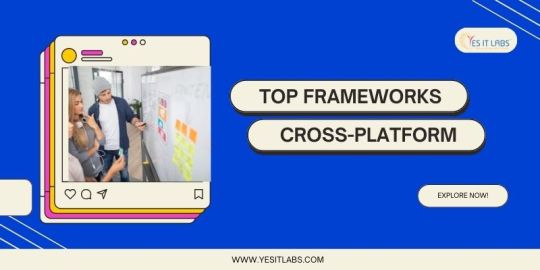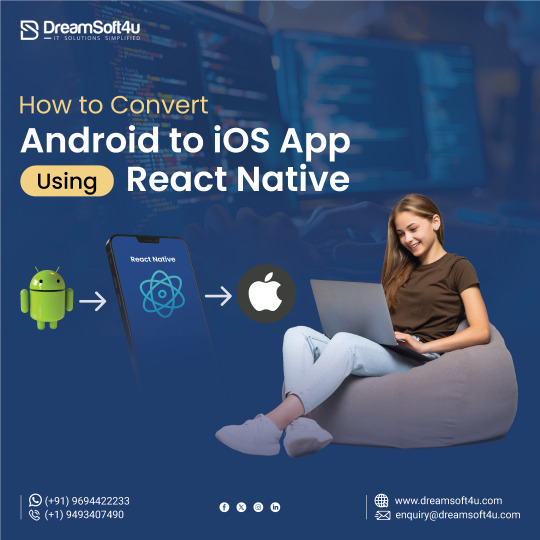#react native cross-platform app development
Explore tagged Tumblr posts
Text
The Ultimate Guide to Cross Platform App Development Frameworks in 2023

However, businesses are now switching to cross-platform app development to reduce development costs and time. Compared to native app development, there are countless benefits that attract companies to choose this method. If you are still thinking about your development approach, this article will shed light on why you should choose cross-platform mobile app development. Cross-platform mobile app development is an approach that allows developers to build a single app for multiple platforms. Developers can use a single codebase, so they don’t have to develop multiple versions of the same application. They can write the code once and deploy it on multiple platforms to streamline development.
#Cross Platform App Development#mobile app development#android app development#app development#mobile application development#app developing company#app developers#Native App Development#React Native App Development#Flutter App Development#Xamarin App Development#ecommerce#marketing#australia#melbourne
1 note
·
View note
Text
React Native App Development Agency – Hire the Best in the Business
Looking to build a powerful mobile app with a single codebase? Our React Native app development agency delivers high-quality cross-platform applications tailored to your business needs. From startups to enterprises, we craft responsive, fast, and feature-rich apps with clean code and intuitive design. If you're ready to hire a react native app development agency, we have the skilled talent and proven process to bring your idea to life. Partner with us for end-to-end development services, transparent communication, and post-launch support that sets your app up for long-term success in a competitive market.
#react native developers for hire#hire react native app development agency#react native experts#offshore cross-platform app making service#hire react native developers#hire a react native developer
0 notes
Text
🤔 Choosing between React Native and Electron for your next cross-platform app? Our latest guide breaks down the pros, cons, and use cases for each! Get the full scoop before you code.
#mobile app development#appdevelopment#app development#react native#react native app development company#cross platform#cross platform mobile app development
0 notes
Text
youtube
Why Swiss Businesses Can’t Ignore These 5 WordPress Trends in 2025 🚀
Swiss businesses relying on WordPress need to prepare for five critical trends in 2025 that will impact performance, user experience, and growth. This video highlights the tools and tactics to modernize your website strategy.
✔ Future-proof your site with AI integrations ✔ Tap into better localization and UX design ✔ Improve site speed, security, and scalability ✔ Optimize for Google’s evolving algorithms ✔ Embrace visual editing and block-based content
Make your website smarter, faster, and ready for 2025.
Check out the original video - https://www.youtube.com/shorts/abeS7adOgao
0 notes
Text
How App Interface Design Is Evolving with AI and User-Centric UX Trends

App Interface Design's Evolution: AI and User-Centric UX Trends Consider this: The average smartphone user touches their device over 2,600 times a day. For heavy users, that figure soars past 5,400. Each tap, swipe, and pinch interacts directly with an interface designed to guide them. But are those interfaces truly serving users in 2025, amidst accelerating technological user-centric UX trends and the pervasive influence of AI in design? The traditional ways we conceived of and built interfaces are rapidly transforming, driven by sophisticated algorithms and a renewed, imperative focus on authentic user-centric design.
The AI Paradigm Shift in Interface Creation
Artificial intelligence isn't merely a tool add-on; it signifies a profound paradigm shift in how we approach the very foundations of app interface design. Overtly, AI automates routine tasks. Subtly, it augments creativity, analyzes colossal datasets with unprecedented alacrity, and stands poised to recalibrate the designer's role entirely. This isn't science fiction anymore; it's the operating reality for forward-thinking design teams.
AI Assisting Design Workflows
Integrating AI assistance into workflows offers tangible improvements in efficiency and opens avenues for novel design possibilities.
Automation of Repetitive Tasks: Tedious activities such as image slicing, code generation for basic components, or initial layout variations can be handled by AI. This frees designers to concentrate on more complex problem-solving, creative conceptualization, and strategic thinking. Think of AI not as replacement, but as a highly efficient junior assistant handling the groundwork.
Generating Design Variations: Based on established brand guidelines, user data, or even initial wireframes, AI algorithms can generate a myriad of design options in moments. This velocity allows for rapid iteration and comparative analysis, potentially unveiling design directions a human might not have considered within the same timeframe.
Predictive Analytics for User Behavior: AI's capacity to sift through vast quantities of usage data identifies patterns and predicts user actions with increasing accuracy. This predictive power directly informs design decisions, allowing interfaces to pre-empt user needs or present information most relevant to an individual's predicted journey within the application.
Ethical Considerations and Bias Mitigation
As AI becomes more entrenched in the design process, acknowledging and actively mitigating inherent biases is absolutely paramount. AI models are trained on data, and if that data reflects societal biases (racial, gender, ability, etc.), the AI will perpetuate them in its design outputs.
Vigilance is required to audit the data sources used for AI training.
Testing AI-generated designs across diverse user demographics is crucial to identify and rectify unfair or exclusionary outcomes.
Maintaining human oversight in crucial decision points of the design process safeguards against automated discrimination or ethically questionable design patterns. Designers become stewards, ensuring the AI serves human well-being and inclusivity.
The Core of User-Centricity in 2025
While technology sprints ahead, the raison d'être of design remains constant: serving the user. User-centric UX trends are less about adopting flashy tech and more about a deeply empathetic approach that prioritizes genuine human needs, contexts, and emotions. In 2025, "user-centric" holds a more nuanced, sophisticated meaning than ever before.
Understanding Evolving User Needs
User expectations aren't static; they morph with technological fluency and societal shifts. A truly user-centric design understands this fluidity.
Hyper-Personalization: Beyond simply using a user's name, personalization now demands interfaces that adapt content, features, and even visual style based on real-time context, historical usage, preferences, and predicted needs. This requires a granular understanding of individual users, facilitated by AI analysis.
Accessibility as a Universal Standard: Designing for accessibility is no longer an afterthought or an optional feature; it is a fundamental requirement. This encompasses not only compliance with guidelines (like WCAG) but designing intuitively for users with diverse cognitive, visual, auditory, and motor abilities from the outset. Inaccessible design effectively excludes large potential user bases.
Emotional Design (Kansei UX): Moving beyond usability, designers now consider the emotional resonance of an interface. Does it feel joyful, trustworthy, calming, exciting? Kansei engineering, originating in Japan, studies how users feel about products. Applying these principles to app interface design fosters deeper user engagement and loyalty by consciously eliciting positive emotional responses.
Measuring and Iterating on User Experience
Good design isn't guesswork; it's an iterative process informed by data and direct user feedback. Measuring the efficacy of designs is foundational to refinement.
Employing robust analytics to track user flows, completion rates, points of friction, and feature engagement.
Conducting diverse forms of user research: usability testing, interviews, surveys, and contextual inquiries.
Utilizing A/B testing and multivariate testing to compare design variations head-to-head based on quantifiable user behavior metrics.
Establishing continuous feedback loops, allowing designers to remain responsive to evolving user sentiments and needs over the product lifecycle.
Synergizing AI and User-Centric Approaches
The true power emerges not from choosing between AI-driven or user-centric design, but by strategically intertwining them. AI, when wielded through a user-centric lens, can elevate interfaces to new heights of relevance, adaptability, and intuitiveness. Conversely, user-centric design principles provide the ethical and humanistic framework that prevents AI from creating sterile, unhelpful, or biased interfaces. This confluence marks the frontier of advanced app interface design.
Designing Adaptive Interfaces
Adaptive interfaces change dynamically based on individual users, their context, and even their momentary state. AI is the engine that makes this feasible on a large scale.
Real-time Customization via AI: Imagine an interface that changes button size for a user walking in bright sunlight, or adjusts complexity for a novice versus an expert user within the same application. AI processes data streams (device sensors, usage history, explicit preferences) to make these interface adjustments happen in the moment.
Contextual Awareness: An interface that knows you're driving might simplify controls; one that knows you're in a quiet library might suggest different features. AI enables applications to understand and react to the user's current environmental and situational context, presenting information and interactions most appropriate to that specific scenario.
Leveraging AI for Deeper User Insights
AI's analytical capabilities allow us to move beyond simple clickstream data to glean profound insights into user motivations, difficulties, and implicit desires.
Beyond Basic Analytics: Instead of just seeing where users click, AI can help understand why they might be hesitating at a certain point, what task they are likely attempting based on partial actions, or how their usage patterns compare to others with similar profiles.
Identifying Implicit Needs: Users often struggle to articulate exactly what they need or want. AI can analyze vast datasets – including user support interactions, social media sentiment, and aggregate usage patterns – to uncover latent needs or points of frustration that users themselves haven't explicitly mentioned.
Building Trust in AI-Powered UX
As AI's role becomes more overt (e.g., a chatbot, a recommendation engine, an interface that visibly rearranges itself), building and maintaining user trust becomes critical.
Transparency in AI Decisions: Users appreciate knowing why something is being recommended, why the interface changed, or why certain options are presented. Explaining the basis of an AI-driven interaction fosters confidence. Avoid 'black box' scenarios where the AI's actions seem arbitrary.
Maintaining Human Oversight: For critical decisions or sensitive interactions, the system should allow for human intervention or fallback options. Users need assurance that they aren't solely at the mercy of an algorithm and can access human support if needed. This hybrid approach leverages AI's strengths while providing a safety net and building trust.
Practical Guide: Navigating the Evolution
Making this transition isn't automatic. It requires a deliberate approach to strategy, a willingness to adapt, and a proactive stance against common pitfalls. Think of this section as laying out actionable considerations for design teams in 2025.
Strategies for Adoption
Successfully integrating AI in design and doubling down on user-centric design demands a multifaceted strategy.
Education and Upskilling: Design teams require new literacies. Understanding basic AI concepts, data interpretation, ethical AI principles, and advanced research methodologies are no longer niche skills; they are becoming foundational. Organizations must invest in continuous learning.
Iterative AI Integration: Do not attempt a monolithic overhaul. Begin by integrating AI into specific, well-defined areas of the design workflow or user experience where its value is clearest (e.g., content personalization, component generation, preliminary usability analysis). Learn from these early efforts and expand incrementally.
Collaboration (Designers, Data Scientists, Users): The future of design is profoundly collaborative. Designers must work hand-in-hand with data scientists to understand the potential and limitations of AI. Critically, users must be involved throughout the process – not just as passive subjects of analysis, but as active participants providing feedback on AI-driven features and adaptive interfaces.
Common Pitfalls to Avoid
The path is fraught with potential missteps. Awareness prevents stumbling.
Over-Reliance on AI: Allowing AI to dictate design without human critique risks generic, soulless interfaces that lack true creativity or empathetic understanding. AI should augment, not supplant, human design intelligence.
Neglecting Human Testing: Believing AI analysis replaces direct human user research is a grave error. AI reveals patterns; qualitative user testing reveals why those patterns exist, uncovers nuances, and captures emotional responses AI cannot.
Ignoring Ethical Implications: Deploying AI-powered interfaces without rigorous ethical vetting can lead to biased experiences, erosion of user trust, and potential reputational damage. Prioritize fairness, transparency, and user control from concept to deployment.
Expert Perspectives and Future Trajectories
Looking ahead, the evolution promises interfaces that are profoundly intuitive, adapting not just to explicit commands but implicit desires and cognitive states. A prominent design leader remarked, "We are moving from interfaces a user learns to navigate, to interfaces that learn the user. The system adapts to you, not the other way around." Another researcher commented, "Ethical frameworks are no longer peripheral; they are the bedrock upon which we build AI-augmented experiences. Without trust and fairness, sophisticated interfaces will simply fail." Emerging areas like Neuro-adaptive UX, which seeks to interpret cognitive signals to tailor interfaces in real-time, or the integration of AR/VR elements facilitated by AI's spatial understanding, signal even more profound shifts on the horizon. The focus will intensify on creating interfaces that feel less like tools and more like seamless extensions of human thought and intent. My personal perspective is that while the technical possibilities are nearly boundless, the most impactful interfaces will be those that remain grounded in empathy, equity, and genuine value creation for the end-user, resisting the temptation of technology for technology's sake.
Key Takeaways
App interface design is fundamentally changing due to AI and refined user-centric UX trends.
AI automates design tasks, generates options, and predicts user behavior, requiring new ethical vigilance.
User-centric design in 2025 mandates deep personalization, universal accessibility, and attention to emotional response.
The synergy of AI and user-centric design enables adaptive, contextually aware interfaces and deeper user insights.
Success requires educating teams, integrating AI iteratively, fostering collaboration, and diligently avoiding pitfalls like neglecting human testing.
The future points toward even more intuitive, perhaps even cognitively aware, interfaces, demanding a persistent focus on ethical, human-first design principles.
Frequently Asked Questions
How is artificial intelligence changing the design role?
AI Automates Mundane Tasks in Design The role pivots from execution toward strategic oversight, prompt crafting, and ensuring ethical outcomes.
What defines contemporary user focus in design today?
Emphasis Placed on Personalized Experiences and Access Design prioritizes individual needs, real-time context, comprehensive accessibility, and emotional impact.
What specific ways does AI benefit user analysis?
AI Provides Deeper Analytical Viewpoints Beyond clicks, it aids in understanding why actions occur, predicting needs, and revealing unspoken frustrations.
Are there major risks integrating artificial intelligence in user interface?
Key Concerns Include Bias and Reliance Excess Risks involve perpetuating data biases, neglecting human insight, and creating interfaces lacking emotional depth.
How should teams prepare for shifts in interface building?
Teams Must Learn Adapt and Stay Current Prepare through continuous education, iterative AI integration trials, and robust interdisciplinary cooperation efforts.
Recommendations
To effectively navigate the dynamic evolution of app interface design, prioritizing adaptation and learning is paramount. Embrace the potential of AI in design as a powerful collaborator, not a replacement. Simultaneously, deepen your commitment to user-centric design, anchoring every technological stride in genuine human needs and experiences. Focus on building ethical safeguards into your process from the outset. The fusion of intelligent systems and profound empathy will define the most impactful and successful interfaces of the future. Ready to future-proof your design strategy and create truly adaptive, user-loved applications? Connect with our team today to explore how leveraging the latest trends can elevate your product experience.
#Application programming#Flutter development#iOS programming#React Native development#Kotlin programming#App creation#Full-stack developers#Swift coding#Android Programming#Application programming experts#App interface design#Cross-platform apps
0 notes
Text
React Native or Native: Which Is Superior for Developing Apps?

In today’s digital ecosystem, mobile applications are pivotal for engaging users and driving business success. One of the earliest decisions developers and business owners must make is choosing the right technology for their mobile apps: React Native or Native development. Each option brings distinct advantages and trade-offs depending on the project's needs, budget, and long-term goals. This blog explores the strengths and limitations of both approaches to help you determine which is superior for your app development journey in 2025 and beyond.
Understanding the Basics: What Is React Native and Native App Development?
React Native is a popular open-source framework created by Meta (formerly Facebook). It allows developers to build cross-platform apps using JavaScript and React. With a single codebase, developers can deploy apps on both Android and iOS, significantly reducing development time and cost.
On the other hand, Native app development refers to building mobile applications specifically for a single platform—Android or iOS—using languages and tools provided by the platform vendor. For Android, this usually means using Java or Kotlin in Android Studio; for iOS, it's Swift or Objective-C in Xcode.
Performance: React Native vs Native App Development

When it comes to performance, native apps generally have the upper hand. Because they’re built using platform-specific languages and APIs, native apps offer smoother animations, better response times, and faster execution. This is especially important for apps that require heavy processing, advanced graphics (like AR/VR or gaming apps), or deep integration with the device hardware.
React Native apps, while impressive in reach and flexibility, rely on a JavaScript bridge to communicate with native modules. This can introduce latency and performance bottlenecks in high-performance applications. However, for many standard use cases—such as e-commerce, social networking, or booking apps—React Native performance is sufficient and increasingly optimized with tools like Hermes engine and JSI (JavaScript Interface).
Keyword tip: Businesses often search for terms like React Native vs Native performance, making it a core comparison factor in decision-making.
Development Speed and Cost: Why React Native Wins

If you’re working with limited time and budget, React Native app development services may be your best bet. With a single codebase for both iOS and Android, developers can create apps faster and cut costs significantly, sometimes up to 40–50% less than building two native apps.
Furthermore, code reusability, live reloading, and modular architecture in React Native enhance development speed and team collaboration. For startups or MVPs aiming for rapid time-to-market, React Native offers a compelling solution without compromising on functionality.
In contrast, native development requires separate teams, toolsets, and codebases for each platform, effectively doubling the effort and cost. While this might make sense for enterprise-grade or mission-critical apps, it can be overkill for simpler projects.
User Experience and UI: Native Still Leads

Native apps are known for delivering a superior user experience. Since they’re built for a specific operating system, native apps can take full advantage of the platform’s UI guidelines, gestures, animations, and components. The result is an app that feels more integrated and intuitive to the user.
React Native tries to replicate native UI components but can sometimes fall short, particularly with platform-specific design elements or highly customized interfaces. While libraries like React Native Paper and NativeBase offer prebuilt components, native still excels in creating pixel-perfect, fluid UIs.
That said, React Native UI is constantly improving, and for many common use cases, it provides a satisfactory and visually pleasing experience. However, for apps where the user interface is a core differentiator, native development has the edge.
Maintenance and Updates: React Native Simplifies It

From a maintenance perspective, React Native simplifies updates due to its unified codebase. Bug fixes, feature updates, and performance improvements can be rolled out simultaneously across both platforms, streamlining app management.
Moreover, tools like CodePush allow for over-the-air (OTA) updates without requiring users to download a new version from the app store. This is a major advantage for agile teams that need to iterate quickly.
Native apps, however, need platform-specific maintenance and updates, which increases the workload and risks inconsistent feature parity between platforms.
Access to Native APIs and Device Features

If your app requires extensive use of native APIs, sensors, or background services (such as Bluetooth, GPS tracking, biometric authentication, or background video processing), native development offers direct access and better control.
React Native, while offering access to many native modules through libraries or custom bridging, can sometimes lag in supporting the latest native APIs immediately. In such cases, native development provides a smoother path to integrate cutting-edge features.
However, React Native has made significant progress in this area with tools like React Native Reanimated, React Navigation, and community-driven modules that support a wide range of native features.
Community Support and Talent Availability

React Native benefits from a massive and active open-source community. With thousands of contributors and extensive documentation, finding React Native developers is relatively easy, and solutions to common issues are readily available.
While native app development also has strong community support, especially for Android and iOS individually, it may require more specialized expertise, which can increase hiring costs and development time.
From a talent acquisition perspective, React Native offers broader flexibility. Developers familiar with JavaScript and React can transition into mobile development more easily than native development, which demands platform-specific knowledge.
Long-Term Scalability and Security

For apps requiring high scalability, robust security, and tight hardware integration—such as banking, fintech, or healthcare apps—native development is often preferred. The performance stability, access control, and OS-level security features make native apps better suited for enterprise-grade solutions.
React Native apps can scale well too, especially with proper architectural planning and the use of native modules. However, security can be a concern if the JavaScript layer isn’t handled properly. Obfuscation, secure storage, and regular audits are essential when using React Native in sensitive domains.
When to Choose React Native
Choose React Native app development if:
You need to build apps for both iOS and Android quickly.
Budget and time constraints are important.
The app doesn't require complex animations or high-performance hardware access.
You're building an MVP or prototype to test the market.
You want faster iterations and simplified maintenance.
When to Choose Native App Development
Choose native app development if:
The app requires maximum performance, such as 3D games or AR/VR apps.
You need to integrate deeply with device hardware or native APIs.
Security and scalability are top priorities (e.g., in fintech or healthcare).
UI/UX customization is a critical part of your user engagement strategy.
You have the resources to maintain separate codebases for iOS and Android.
Final Verdict: Which Is Superior?
There’s no one-size-fits-all answer. The superior approach—React Native or Native—depends entirely on your project’s goals, complexity, and constraints. React Native is a great choice for startups, cross-platform solutions, and rapid development. Native development, on the other hand, remains unbeatable for performance-critical, secure, and UI-intensive applications.
Partnering with the right mobile app development company is key to evaluating your needs and choosing the best technology. Whether you opt for React Native or native app development, ensure that your chosen team has deep expertise and a clear understanding of your industry requirements.
#Which is better React Native or Native for app development#React Native vs Native app performance comparison#Cost-effective mobile app development in 2025#Best choice for cross-platform app development#Choosing between React Native and Native in 2025#React Native performance#Native app advantages#React Native pros and cons#Native vs cross-platform development#Swift and Kotlin app development#Best framework for mobile app development#iOS and Android app development#Mobile development technologies 2025
0 notes
Text
0 notes
Text
Building Cross-Platform Mobile Apps: Flutter vs React Native in 2025
0 notes
Text
How to Choose the Best App Development Company in Canada 2025

The Canadian app development market is booming, with businesses of all sizes recognizing the value of mobile applications in reaching customers, streamlining operations, and driving growth. Finding the right partner to bring your app idea to life is crucial in this competitive landscape. This guide will provide you with a comprehensive overview of how to choose the Best App Development Services in Canada in 2025.
1. Define Your Project Requirements
Before you start researching companies, clarify your app's specific needs and goals. Ask yourself the following questions:

What problem will your app solve?
Who is your target audience?
What are the essential features and functionalities?
What is your budget and timeline?
What platforms (iOS, Android, or both) do you need to support?
Having a clear understanding of your requirements will help you narrow down your search and communicate effectively with potential development partners.
2. Research and Identify Potential Companies
Start your search online. Use search engines, industry directories, and review websites to identify potential app development companies in Canada. Look for companies with a strong portfolio, positive client testimonials, and relevant experience in your industry. If you're based in Alberta, specifically research for an App Development Company in Calgary.

3. Evaluate Their Portfolio and Experience
A company's portfolio is a window into their capabilities and expertise. Review their past projects to assess the quality of their work, their design aesthetic, and their technical skills. Look for projects that are similar to your own in terms of complexity, functionality, and industry.
Pay attention to the technologies they use. Are they up-to-date with the latest trends and frameworks? For instance, if you plan to develop a cross-platform application then enquire if they Hire React Native App Developer.
4. Check Client Testimonials and Reviews
Client testimonials and reviews provide valuable insights into a company's reputation and customer service. Look for feedback on their communication, project management, technical expertise, and overall satisfaction. Check independent review sites like Clutch, GoodFirms, and Trustpilot to get unbiased opinions.
5. Assess Their Technical Expertise and Development Process
A reliable app development company should have a well-defined development process that includes:

Planning and Discovery: Thoroughly understanding your requirements and creating a detailed project plan.
Design: Creating wireframes, mockups, and prototypes to visualize the app's user interface and user experience (UI/UX).
Development: Writing clean, efficient, and well-documented code.
Testing: Rigorous testing to identify and fix bugs.
Deployment: Launching the app on the app stores.
Maintenance and Support: Providing ongoing maintenance and support to ensure the app's stability and performance.
6. Consider Their Communication and Project Management Skills
Effective communication is essential for a successful app development project. The company should be responsive, transparent, and proactive in keeping you informed of progress. They should also have a robust project management system in place to track tasks, manage deadlines, and ensure that the project stays on track.
7. Evaluate Their Location and Team Structure
While remote collaboration is common, consider the benefits of working with a local company, especially if you value face-to-face meetings and on-site collaboration. An IT Agency in Calgary would be ideal if you're in Calgary. Understand the team structure and the roles of each team member.
8. Discuss Pricing and Payment Terms
Get a clear understanding of the company's pricing model and payment terms. Do they charge hourly, fixed-price, or value-based pricing? Make sure you understand what's included in the price and what's not. Also, clarify the payment schedule and any potential extra costs.
9. Consider Long-Term Support and Maintenance
App development doesn't end with the launch. You'll need ongoing maintenance and support to fix bugs, update features, and ensure compatibility with new operating systems and devices. Choose a company that offers long-term support and maintenance services.

Conclusion
Choosing the best app development company requires careful research and evaluation. By defining your project requirements, researching potential partners, and assessing their skills and experience, you can find a company that can bring your app idea to life and help you achieve your business goals.
This article provides a comprehensive guide on how to select the best app development company in Canada in 2025. It emphasizes the importance of defining project requirements, evaluating portfolios, checking client reviews, assessing technical expertise, and considering communication and project management skills. It also highlights the need for long-term support and maintenance.
At A Square V Solutions, we pride ourselves on being a leading provider of innovative and user-centric app development services in Canada. With a team of experienced developers, designers, and project managers, we are committed to delivering high-quality solutions that meet the unique needs of our clients. Contact us today to discuss your app development project and learn how we can help you succeed in the mobile world.
#Best App Development Services in Canada#App Development Company in Calgary#React Native App Development Company#Top ios App Development Company in USA#Cross Platform App Development Company Canada
0 notes
Text
React Native Vs. Flutter: Which Framework is Right for Your App?
In this blog we shares all about React Native Vs. Flutter: Which Framework is Right for Your App? And When to Choose Flutter App Development, When to Choose React Native App Development. If you want to Build the best mobile application development company in Rajkot, Contact Aphonic Solutions now!

#cross-platform app development#mobile application development company in Rajkot#React Native Vs. Flutter#When to Choose Flutter App Development#When to Choose React Native App Development
0 notes
Text
#Hybrid Mobile Apps#Cross-Platform Development#Mobile App Development#Hybrid App Frameworks#Responsive Mobile Design#Ionic Framework#Cordova#React Native#Mobile User Experience#App Performance Optimization
0 notes
Text
Improving User Experience in Cross-Platform Mobile Apps
React native is a framework that has been introduced by Facebook for a smooth and easy cross platform mobile app development. It simply eliminates the need of creating separate apps for IOS and Android platforms. It has also put a full stop to the confusion that most of the entrepreneurs face in selecting a cost effective solution for their businesses.
#React Native App Development Services#Cross Platform Mobile App Development#React Native App Development Company in Vadodara
0 notes
Text
Learn how to develop iOS apps on Windows using smart tools, emulators and cloud-based solutions in a few easy steps.
#mobile app development#appdevelopment#react native#cross platform#ios app development#ios#microsoft windows
0 notes
Text
youtube
Build Apps Faster & Save 40%: Cross-Platform Development Explained!
Swiss businesses relying on WordPress need to prepare for five critical trends in 2025 that will impact performance, user experience, and growth. This video highlights the tools and tactics to modernize your website strategy.
✔ Future-proof your site with AI integrations ✔ Tap into better localization and UX design ✔ Improve site speed, security, and scalability ✔ Optimize for Google’s evolving algorithms ✔ Embrace visual editing and block-based content
Make your website smarter, faster, and ready for 2025.
Check out the original video - https://www.youtube.com/shorts/abeS7adOgao
#Cross Platform Development#React Native Mobile App Trends#App Development 2025#Cross platform app development#Flutter app development company#React Native app development#Build app for Android and iOS#Mobile app development cost reduction#Youtube
0 notes
Text
Top Frameworks for Cross-Platform App Development in 2025
The best cross-platform frameworks in 2025 will help you develop apps that run smoothly on all platforms while saving time, cost, and resources.

#cross-platform app development framework#native ARM code#nativescript vs react native#custom website development service#mobile applications developers#web developer freelancers
0 notes
Text

Are you planning to convert your Android to iOS app using React Native? If Yes, then this guide will help you. Nowadays, React Native has become the ultimate solution for businesses who want to build a mobile app. One thing that makes react native most popular for developers is that developers can write code once and build an app for both Android and iOS and don’t need to write separate code for each OS.
#ios app development company#ios app development services#ios app developer#cross-platform app development#android to ios app#react native mobile app development#android app development company
1 note
·
View note